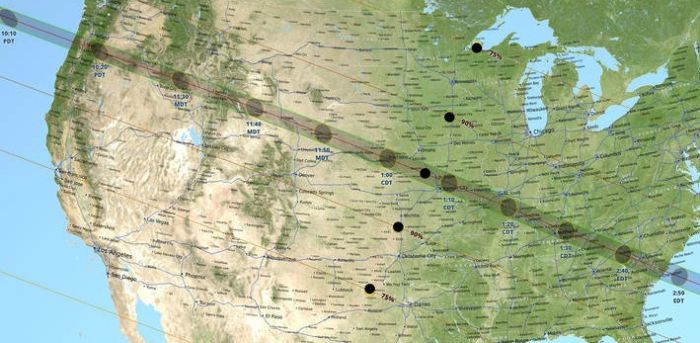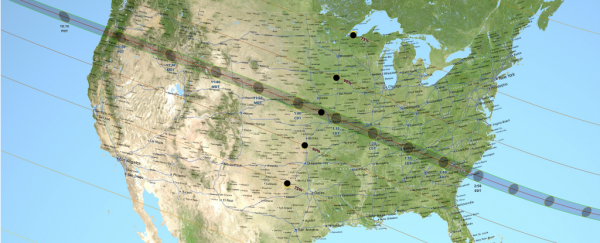Get ready North America, the Great American Eclipse is only seven months away. On 21 August this year, the first total solar eclipse since 1979 will cast its shadow across the majority of the US.
Now, I know you're probably thinking that seven months is an awfully long time to prepare, but the best viewing spots are basically already gone, and we'd probably recommend getting a move on if you want to see a full solar eclipse.
"All of a sudden, you know, you see a 360-degree sunset all around you," said NASA's Lika Guhathakurta last month at a meeting of the American Geophysical Union.
"Stars appear. The temperature drops. You can actually hear chirping of grasshoppers. So, animals actually naturally go back to their nocturnal behaviour."
"A total solar eclipse, I would say, is widely regarded as probably one of the most breath-taking, amazing phenomena that you can observe from this planet Earth with your own eyes," she added.
Where to Watch:
In most areas of the US you'll see a pretty spectacular partial eclipse, but there's a thin line across the country where you'll witness a total eclipse. This is where the prime locations will be:
Moon’s shadow landfalls Oregon, crosses USA at 1800mph, exits SCarolina. Behold ‘Muuurica’s Eclipse. pic.twitter.com/fIMCnEyyQy
— Neil deGrasse Tyson (@neiltyson) August 21, 2016
That path of totality will be 112-km (70-mile) wide – with the ideal spot to watch being Madras, Oregon.
As Bec Crew wrote for us back in August:
"According to the Madras-Jefferson County Chamber of Commerce, the Moon will begin to pass in front of the Sun at 9:06am, and by 10:19am, people in Madras will see the Sun obscured for up to 2.5 minutes.
But good luck finding a hotel room if you want to make a day of it. Madras officials expect some 30,000 tourists to visit during the eclipse, but they only have 325 hotel rooms within city limits. Some rooms have been booked out by international tourists for a year already."
But don't stress if you can't get a reservation. There are 12 states where the Sun will be completely blotted out, and other cities pretty close to the ideal spot include Salem, Corvallis, Grand Island, Lincoln, Greenville, and Columbia.
We're not kidding when we say get in now though, full hotels and price gouging has been seen across the country, and even areas that will only see a full eclipse for a few seconds are getting full.
But if you start looking now, and are prepared to drive for a few hours once you find accommodation, you should still be able to find an amazing location.
What time is it happening?
The total eclipse will happen through a narrow band at various times on August 21. The region of totality hits the west coast at around 17:16 UT, and will hit the Atlantic about 90 minutes later at 18:48 UT.
If you want to see approximates times for your location, check out NASA's infographic below, or see more information on their site.
 NASA/Goddard/SVS/Ernie Wright
NASA/Goddard/SVS/Ernie Wright
You can see a bigger version here.
Why do Solar Eclipses Happen?
By crazy coincidence, the Sun is around 400 times wider than the Moon, but is also 400 times further away – meaning that the two look the same size from Earth.
When they line up, the Sun is nearly perfectly blocked by the Moon, plunging an area of the earth into total darkness.
"With unaided eyes, you can actually see the outer atmosphere of the sun," said Guhathakurta.
As Mike Wall, from Space.com explains, this happens more commonly than you might think – although not always in the areas you want.
"This happens somewhere on Earth just once every 18 months or so, though partial solar eclipses - in which the moon takes a bite out of the solar disk - are more common," he added.
However, this is the first time in 99 years that a total solar eclipse has been so accessible to Americans on both coasts, plus this is the first ever solar eclipse where the path of totality occurs exclusively in the US. (The one before, in 1776 was before America's independence.)
We won't have to wait quite as long until the next one though, in 8 April 2024 the next total solar eclipse will hit Mexico, the United States, and Canada.
Finally, if you're lucky enough to be somewhere where you can see it – make sure you wear your eclipse glasses – your regular sunglasses won't cut it on the day!
If you're anywhere else in the world but the US all is not lost – you can see a livestream on the day here.
